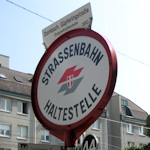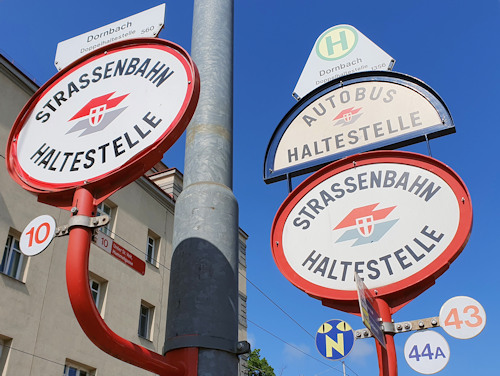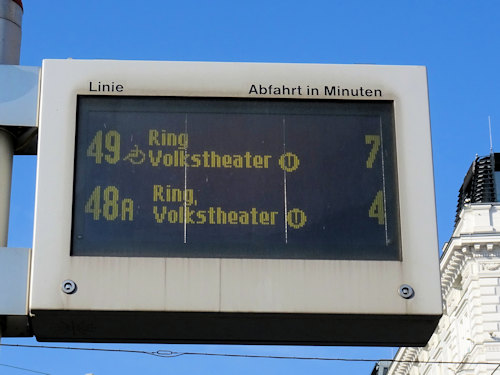
The photo below is from a typical tram stop in Vienna. But what do all those words, symbols, and various signs mean?
Let me reveal all…
- See also:
“Sign language”

(The main kind of tram stop sign)
Many visitors choose to use the efficient public transport system to get around the city. So it helps to know your way around a tram or bus stop.
First of all, the large black lettering in the red-rimmed oval (STRASSENBAHN HALTESTELLE) means “tram stop.” A Haltestelle is a stop for a bus or tram. And Straßenbahn is the German for tram: literally “street train”.
The letters in the blue-rimmed semi-circle say AUTOBUS HALTESTELLE. No prizes for guessing that this means “bus stop”. So this particular platform doubles as both a tram and bus stop.

(I’m going to hazard a guess that this might be a Haltestelle)
You find the name of the stop or station on every sign at the top. In the photo above, it’s Dornbach: a stop in Vienna’s 17th district.
The red number (49, 10 and 43 in the photos) tells you the name of the tram line that serves this location. The blue number (48a and 44A) gives the name of the bus line. Should you see a similar sign with the letter N and a pair of cat’s eyes, this indicates that a special night service stops here, too.
Below those numbers or on a separate pole you have timetables for the relevant trams and/or buses. These give the names of the stops along the line, the time it takes to reach each of these stops, and the intervals between trams/buses for various periods of the day.

(Signs giving the direction and final stop for services)
Smaller signs typically stick out from the post marking a tram stop. The above photo has an example.
These signs repeat the number or letter of the tram line(s), point in the direction the tram leaves from the stop, and list the name of the last station on the line.
In this case, you can see that the 43 tram goes to Schottentor as its final destination. The U symbol tells you there’s subway (German: U-Bahn) access at Schottentor. The N43 is the nighttime version of the 43.
One further sign at most (but not all) stops is an electronic display providing up-to-date timetable information. Like this:

(How many minutes you have to wait)
The number on the left is the bus or tram line (so the 49 tram and 48A bus).
The words in the middle are the final destination (the Ring, Volkstheater stop, also with subway access).
And the number on the right is how many minutes until the next vehicle is expected to depart from this stop.
The mini wheelchair symbol next to the 49 tells you the tram is wheelchair-friendly, with a low floor for boarding and dedicated space for wheelchairs. (Good to know if you have a pram, too)
The minutes until departure may cycle through the next couple of vehicles. That’s why the number might change unexpectedly. So if it jumps from 3 mins to 9 mins and then back to 3 mins, it simply means the next tram is 3 minutes away and the one after that is 9 minutes away.
If a stop serves more than two or three lines, then the electronic sign may cycle through them: if you can’t see the tram or bus number you’re looking for right away, just wait a while.
The transport authorities sometimes use the display for relevant messaging, too, such as when an accident en route means a lengthy delay or to express solidarity with some cause or another.
And finally…
New sign designs have begun appearing as part of modernisation programmes, but these remain relatively rare in the centre at the time of writing. The concept is similar to the old one, though.
Happy travels.